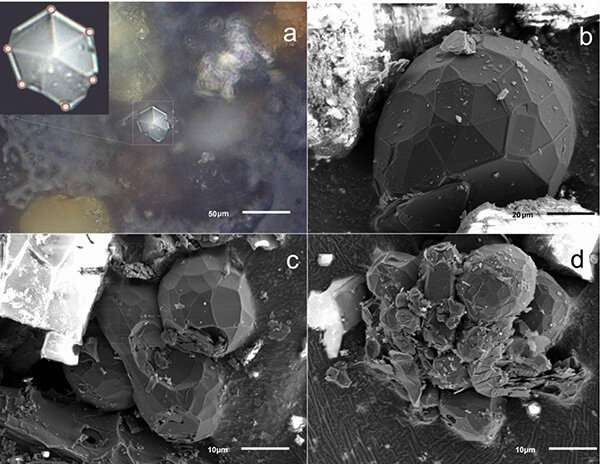Images of carbon microcrystals taken with (a) optical and (b)–(d) scanning electron microscopes. Credit: The European Physical Journal Plus (2022). DOI: 10.1140/epjp/s13360-022-02768-7
Unusually shaped microcrystals formed of pure, graphite-like carbon were discovered in the dust of the 21st-century's largest meteorite. They are likely to have grown in layers from complex carbon nuclei such as fullerene.
The largest meteorite observed so far this century entered the Earth's atmosphere above Chelyabinsk in the Southern Urals, Russia on February 15, 2013. Unusually, dust from the surface of this meteorite survived its fall and is being extensively studied. This dust includes some unusually shaped microcrystals of carbon. A study of the morphology and simulations of the formation of these crystals by a consortium led by Sergey Taskaev and Vladimir Khovaylo from Chelyabinsk State University, Russia is now published in the journal The European Physical Journal Plus.
Meteorite dust is formed on the surface of a meteor when it is exposed to high temperatures and intense pressures on entering the atmosphere. The Chelyabinsk meteor was unique in its size, the intensity of the air burst in which it exploded, the size of the largest fragments that fell to earth and the damage that it caused. More relevantly, it fell onto snowy ground and the snow helped to preserve its dust intact.
Taskaev, Khovaylo and their team first observed micrometer-sized carbon microcrystals in this dust under a light microscope. They therefore examined the same crystals using scanning electron microscopy (SEM) and found that they took up a variety of unusual shapes: closed, quasi-spherical shells and hexagonal rods. Further analysis using Raman spectroscopy and X-ray crystallography showed that the carbon crystals were, actually, exotically-shaped forms of graphite.
Most likely, these structures will have been formed by repeatedly adding graphene layers to closed carbon nuclei. The researchers explored this process through molecular dynamics simulations of the growth of a number of such structures. They found two "likely suspects" as nuclei for microcrystal growth: the spherical fullerene (or buckminsterfullerene), C60,and the more complex hexacyclooctadecane (C18H12). In conclusion, Taskaev and Khovaylo suggest that classifying these crystals could help identify past meteorites.
More information: Sergey Taskaev et al, Exotic carbon microcrystals in meteoritic dust of the Chelyabinsk superbolide: experimental investigations and theoretical scenarios of their formation, The European Physical Journal Plus (2022). DOI: 10.1140/epjp/s13360-022-02768-7
Provided by Springer
























